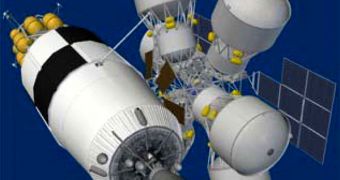The American space agency announces that it has just awarded four individual contracts to companies that announced their intention to start research on orbital refueling technologies. In order to move beyond low-Earth orbit (LEO) with more astronauts and larger spacecraft, these gas stations are needed.
NASA has been arguing for a long time that constructing gas stations in space would enable rockets to deliver more cargo, and minimize the space needed to transport fuel. It would also be cheaper to launch fuel payloads only to these facilities, since docking and transfer would be performed automatically.
The main challenge researchers need to eliminate is how to maintain rocket propellant at supercold temperatures. Usually, thrusters consume liquid oxygen and liquid hydrogen, chemicals that boil off into gases if not stored at extremely low temperatures.
At the same time, fuel containers need to be protected, so that micrometeorite or space debris impacts do not cause the fuel to leak. Orbital safety would be paramount for any spacecraft approaching an orbital fuel dock for resupply, Space reports.
“Storing cryogenic propellants such as liquid hydrogen and liquid oxygen in space for long periods of time with minimal boil-off is critical for deep space human exploration,” a NASA statement explains.
Officials with the agency say that not even orbital gas stations may not be enough. If we want to explore the Moon, near-Earth asteroids and Mars properly, we may need to install resupply points on these celestial objects as well.
In order to determine the technical challenges associated with constructing and deploying such structures, NASA set its Exploration Technology Development Program (ETDP) into motion.
Recently, the program was used to award $2.4 million in funding to four companies that will conduct feasibility and design studies. These companies will need to deal with all aspects of this issue.
“Each company will provide a final report to help define a mission concept to demonstrate the cryogenic fluid management technologies, capabilities and infrastructure required for sustainable, affordable human presence in space,” the same NASA statement adds.
The four companies are Hampton, Virginia-based Analytical Mechanics Associates Inc., Boulder, Colorado-based Ball Aerospace & Technologies Corporation, Huntington Beach, California-based Boeing Company and Littleton, Colorado-based Lockheed Martin Space Systems Company.
Perhaps the most important aspect of the new studies will be identifying the technological gaps that currently prevent us from building these gas stations outright. The teams will also determine what research needs to be conducted in order for these gaps to be covered as soon as possible.
NASA is already testing the Robotic Refueling Mission (RRM) experiment, which was delivered to the International Space Station by the space shuttle Atlantis, during its final mission. The instrument is meant to facilitate refueling satellites in orbit, therefore extending their operational life considerably.

 14 DAY TRIAL //
14 DAY TRIAL //